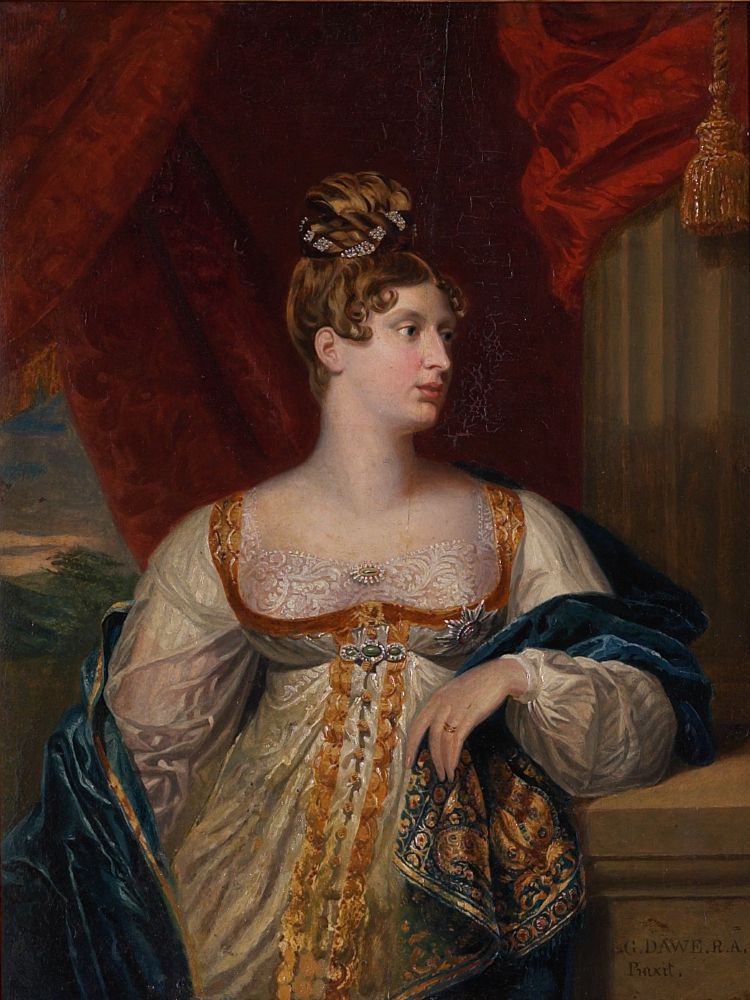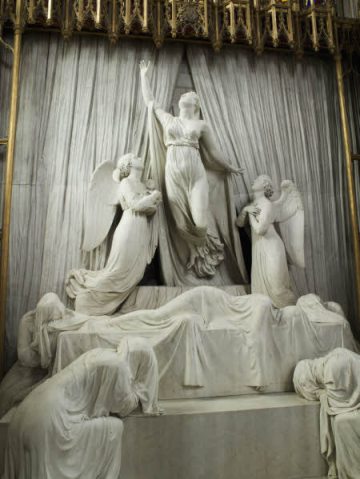by Susan Flantzer © Unofficial Royalty 2013

Princess Charlotte of Wales; Credit – Wikipedia
Not many people remember Princess Charlotte of Wales, but I think it is important that she be remembered and that it is understood how her death affected the British succession.
Princess Charlotte of Wales was the only child of George, Prince of Wales, the future King George IV, and the only legitimate grandchild of King George III. She married Prince Leopold of Saxe-Coburg-Saafeld, the future uncle of Queen Victoria of the United Kingdom and her husband Prince Albert of Saxe-Coburg and Gotha, and the future Leopold I, King of the Belgians. Charlotte suffered two miscarriages in the early months of her first two pregnancies, but the third pregnancy in 1817 gave Charlotte and Leopold hope. After a labor of over 50 hours, Charlotte delivered a stillborn son. Several hours later, twenty-one-year-old Princess Charlotte died of postpartum hemorrhage on November 6, 1817. Had Charlotte lived, she would have succeeded her father as Queen of the United Kingdom. Charlotte was mourned by the British people like the mourning of Diana, Princess of Wales. Her pregnancy and delivery were grossly mismanaged and the doctor in charge, Sir Richard Croft, who later died by suicide.
At the time of her death, Charlotte, who was second in line to the throne, was the only legitimate grandchild of King George III, even though eleven of his fifteen children were still living. Charlotte’s death left no legitimate heir in the second generation and prompted the aging sons of King George III to begin a frantic search for brides to provide for the succession.
King George III’s eldest son (Charlotte’s father) and his second son Frederick, Duke of York, were in loveless marriages, and their wives, both in their late forties, were not expected to produce heirs. The third son William, Duke of Clarence, age 53, married 26-year-old Adelaide of Saxe-Meiningen. 50-year-old Edward, Duke of Kent, the fourth son, married 32-year-old widow Victoire of Saxe-Coburg-Saafeld. Victoire was the sister of Leopold, Princess Charlotte’s widower. 21-year-old Augusta of Hesse-Kassel was married to 44-year-old Adolphus, Duke of Cambridge, the seventh son. It was then the scramble to produce an heir began.
Within a short time, the three new Duchesses, along with Frederica, wife of the fifth son Ernest, Duke of Cumberland, became pregnant. Augusta gave birth to a son on March 26, 1819; Adelaide had a daughter the following day. Victoire produced a daughter on May 24, 1819, and three days later Frederica had a boy. Adelaide’s daughter would have been the heir but the little princess died in infancy. The child of the next Royal Duke in seniority stood to inherit the throne. This was Alexandrina Victoria, daughter of Edward, Duke of Kent and Victoire of Saxe-Coburg-Saafeld. The baby stood fifth in line to the throne after her uncles George, Frederick and William, and her father Edward.
The baby’s father Edward died on January 23, 1820, eight months after her birth. Six days later, King George III’s death brought his eldest son to the throne as King George IV. Frederick, Duke of York, died in 1827, bringing the young princess a step closer to the throne. King George IV died in 1830 and his brother William (IV) succeeded him. During King William IV’s reign little Drina, as she was called, was the heiress presumptive. There was always the possibility that King William IV and Queen Adelaide would still produce an heir but it was not to be. William died on June 20, 1837, and left the throne to his 18-year-old niece, who is known to history as Queen Victoria.
Read more about Queen Victoria and her family at House of Hanover: Queen Victoria Index.

Queen Victoria’s coronation portrait, Credit – Wikipedia
This article is the intellectual property of Unofficial Royalty and is NOT TO BE COPIED, EDITED, OR POSTED IN ANY FORM ON ANOTHER WEBSITE under any circumstances. It is permissible to use a link that directs to Unofficial Royalty.

